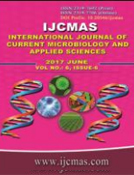


 National Academy of Agricultural Sciences (NAAS)
National Academy of Agricultural Sciences (NAAS)

|
PRINT ISSN : 2319-7692
Online ISSN : 2319-7706 Issues : 12 per year Publisher : Excellent Publishers Email : editorijcmas@gmail.com / submit@ijcmas.com Editor-in-chief: Dr.M.Prakash Index Copernicus ICV 2018: 95.39 NAAS RATING 2020: 5.38 |
It believed that the domestication of animals and crops was done by the women in the ancient age, thereby initiated the art and science of farming. In the present context,rural women folk are extensively involved in agricultural and allied activities, their work has been increased from home to land and vice-versa. However the nature and extent of their involvement differs in different geographic location. Therefore in order to explore the gender involvement in various feeding practices for dairy animals, the study was conducted in two district of Manipur i.e. Imphal East and Imphal West. The total 160 respondents (Men and Women) were selected from eight villages for investigation. The men and women were separately interviewed. The data was collected enthusiastically followed by analysis and interpretation. The analysis was done by using of appropriate statistical tools. After successful analysis it was found that the practices related to fodder cultivation such as purchasing of seeds, sowing of seeds, giving irrigation, weeding of fodder crops etc. we’re not doing vigorously. The result shows that the majority of the male (77.50%) engaged in gathering of fodders from the fields. Purchase of Concentrate (21.25%), preparation of feed mixture (48.75%), feeding of pregnant animals (11.25%), harvesting of fodder crops (2.50%) were done by the women respectively. Overall observation was that the farmers in the region were not interested in commercial dairy farming, so the cultivation of fodder crops is a questionable. Those who are rearing dairy animals, their major source of green fodder is from the forest, common property resources. Lastly, it is highly recommended that the dairy sector has good future in the region, but foremost things to bring interest of the people towards milk & milk products is the major challenge.
 |
 |
 |
 |
 |